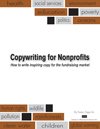After your website, email is arguably the second most important online tool for charities and associations. Follow these seven email guidelines and your readers will respond more often. Your nonprofit and those you serve will benefit. After all, isn’t that what’s most important?
1 – What is the purpose or objective of the email? Define and write the answer to this question before writing another word of copy.
Do you want association members to register for your annual conference?
Do you want donors to help you find volunteers that will augment the music, dance, theatre and other arts programs in the schools you support?
2 – From line: Will EVERYONE recognize the name? Try a combination of a person’s name and your organization. Test your “sender” thoroughly. Why? Because the FROM line is the main reason people delete email without opening or reading. They don’t recognize the sender.
From: Martha Watson – Chicago Children’s Hospital
3 – Subject line: This is the second determining factor on whether an email will be deleted or opened. Think of it as a headline and give it all the time and effort it deserves. You must also connect the copy within the body of your email to the subject line.
Also, the purpose of your email influences the subject line.
For example: If the purpose is to acknowledge a renewal from a member, then the subject line might be … “Thank you, Marvin Joiner.” Or perhaps, “Thank you for renewing your membership.”
4 – Keep it short. Say, 300 words or less if possible. Write it for skimmers and scanners – readers glancing over the copy to see if it’s worth reading more carefully. Accomplish this with short paragraphs; subheads, bullets, selective bolding of text, and hyperlinks that show up (i.e., underlined blue font).
5 – Open with a blast. Immediately share the purpose, benefit and call to action in your first few sentences. People will ignore an email 100 times faster than a 10-page white paper or special report. (Okay. That’s my shoot from the hip estimate and not based on extensive scientific study.) So they need to instantly know, “Why should I read this? What do I get out of it?”
Tied to this is the fact that many people read or skim emails using the preview window – they never actually “open” the email. Make the benefit of reading the email visible in the preview pane. This first paragraph is also a good place to include a hypertext link.
6 – Reader-centered copy. It must provide your donor or member with value. You must share the information SHE wants to receive.
ME-ME-ME Charity-centered copy: “We have been saving lives through research for 43 years. Our doctors and scientists have worked to ….”
Reader or Donor-centered copy: “Your generosity has helped make life-saving breakthroughs in research possible. Let me introduce you to someone whose life was recently saved … thanks to you.”
7 – Don’t rely on graphics. Many people will only see them as empty boxes with a small red “x” in them. And there are plenty of folks who only receive plaintext emails which negates the graphics completely. Your copy must convey your message independent of any graphics. I’ll take this opportunity to add an editorial comment . . . it’s annoying as heck to receive an email that is nothing but empty graphic boxes. I can’t read a darn thing until I right-click to download images. Many times I don’t even bother; I just delete regardless of who the sender is. Don’t rely on graphics.
Put these seven email guidelines into action and I believe you’ll see a jump in response. Give readers what they want. Also make it easy for readers and everyone benefits – particularly those you serve.

{ 2 trackbacks }
{ 0 comments… add one now }